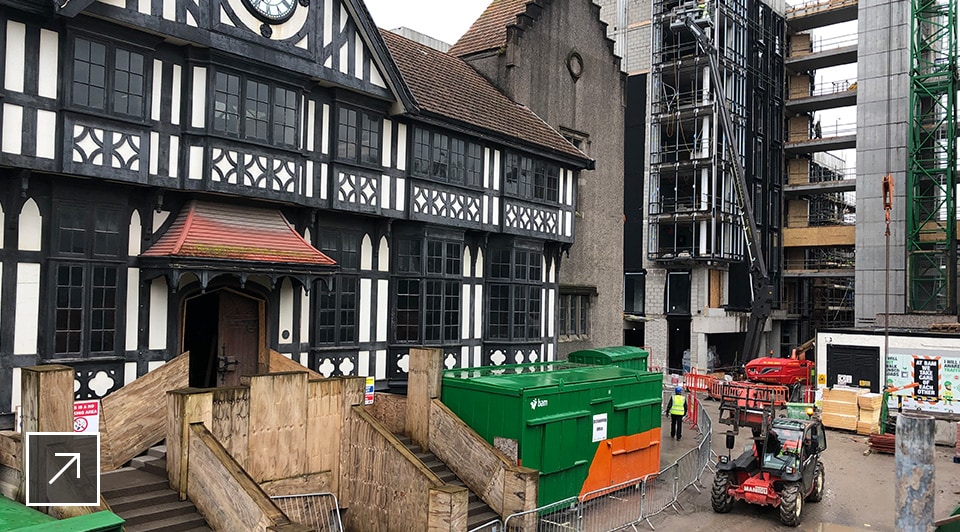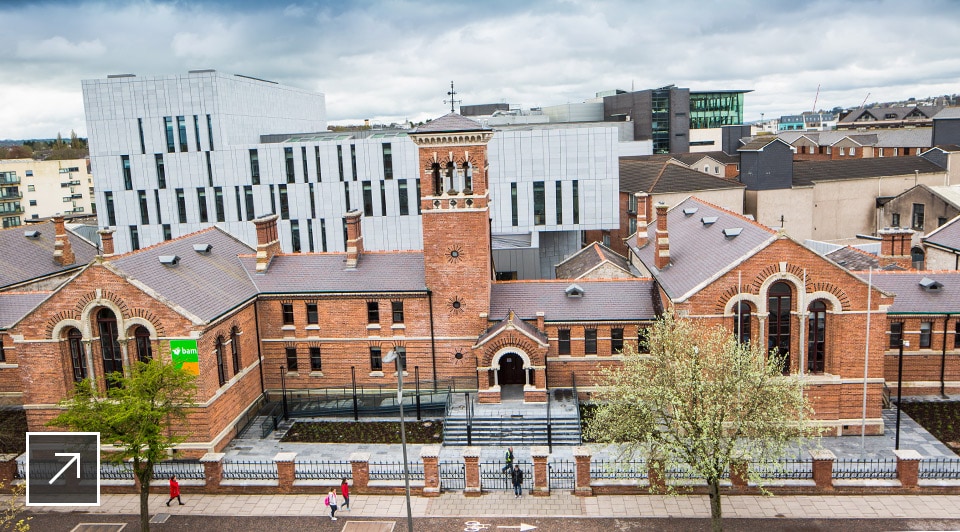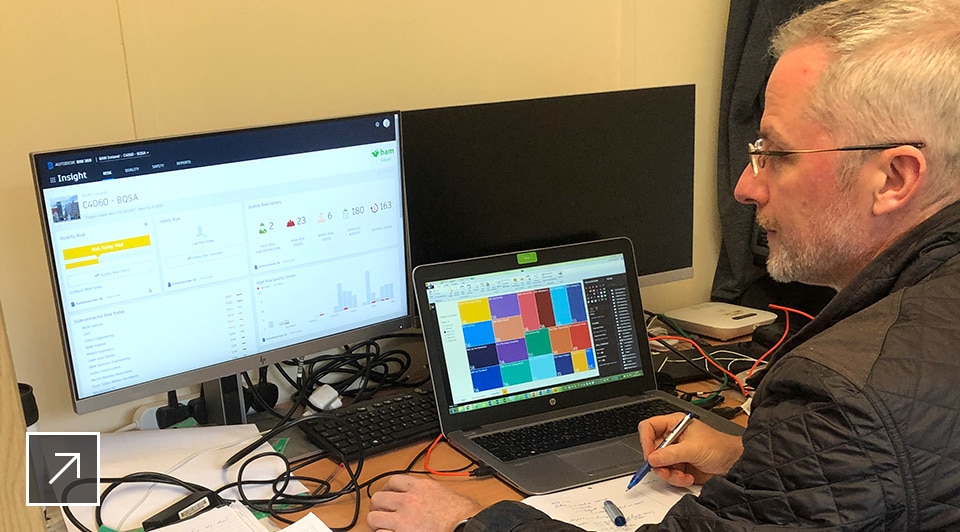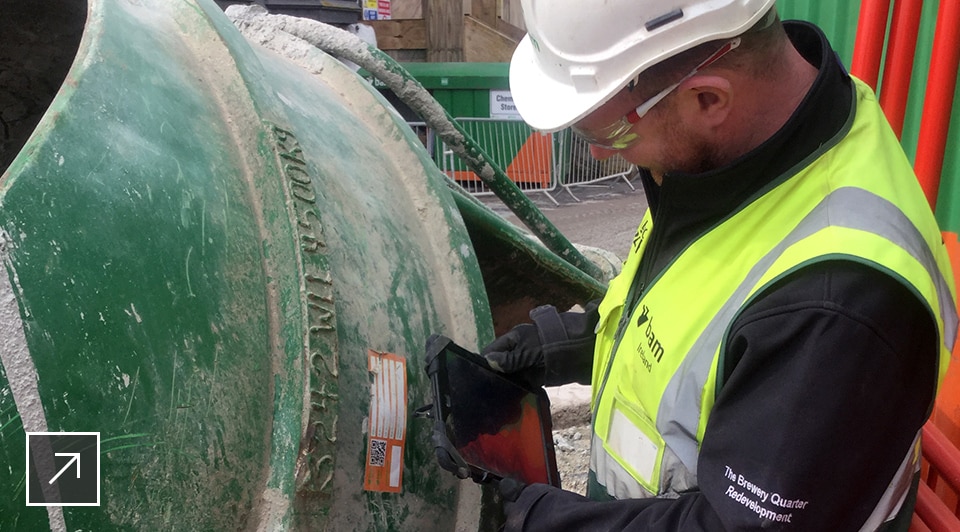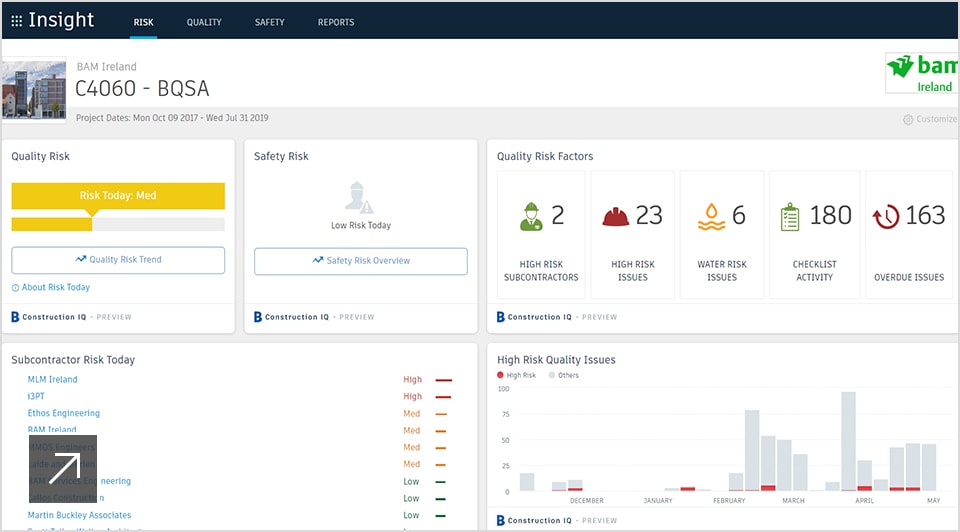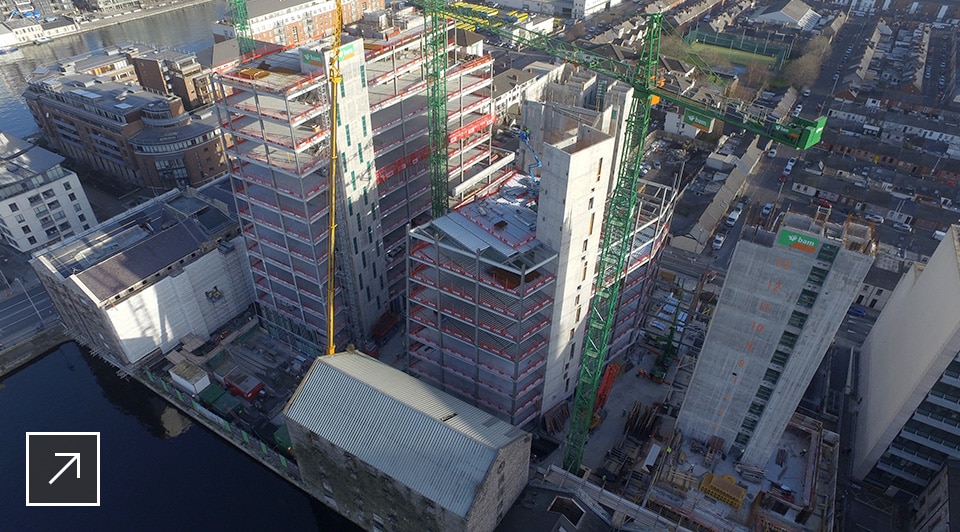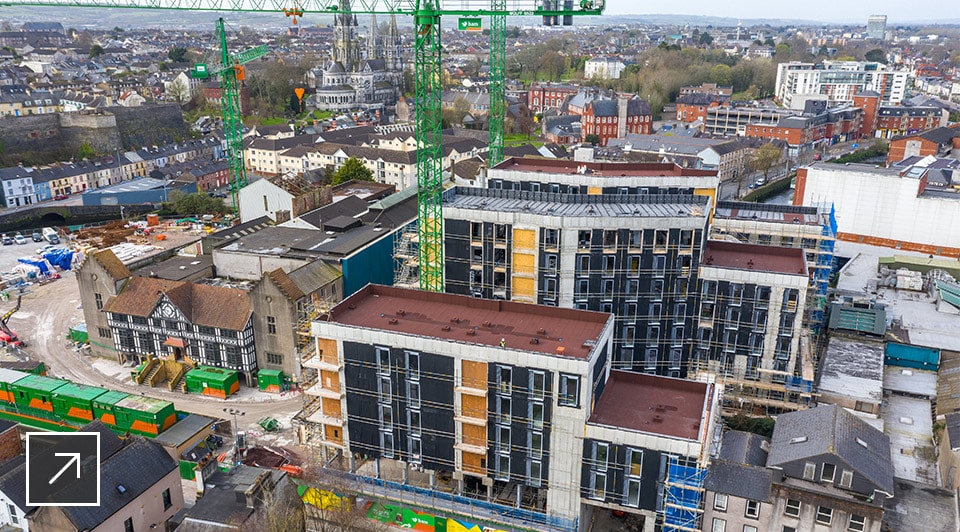Worldwide Sites
You have been detected as being from . Where applicable, you can see country-specific product information, offers, and pricing.
Keyboard ALT + g to toggle grid overlay
Finding better ways to build Ireland
Ireland abounds with architectural treasures, from majestic castles and handsome Georgian buildings to innovative, state-of-the-art office towers. Clearly, the Irish know how to build. But in a culture with such deep-rooted construction traditions, can today’s builders learn new ways of working?
BAM Ireland is living proof that they can. It was established in 1958 as Ascon Contractors and rebranded as BAM Contractors in 2008. The company was conceived from a Dutch-Irish joint venture that built Ireland’s Wexford Bridge, and today it’s the country’s largest civil engineering and public-works contractor. BAM Ireland also has a long history of evolving to serve new clients, industries, and project types—and using new technologies.
“In the past six years, we’ve moved heavily into the building sphere and accelerated our use of technology in a big way,” says Digital Construction Operations Manager Michael Murphy. “We’re all about doing things better, doing better things, and doing new things right now. That’s our mantra.”
An appetite for innovation
BAM Ireland began adopting technology in earnest in 2013. “Ireland was only beginning to emerge from quite a tough time then,” Murphy says. “We were coming out the back of a major recession, and margins on projects were incredibly tight; it was hard to win a job. We were carrying quite a bit of risk on our projects as well, so the organization was actively looking for better ways to work and smarter ways to deliver buildings.”
In technology, the firm saw not only short-term benefits but also long-term possibilities. “Something that really sets us apart in our field is that we’re very into lifecycle,” Murphy says. “BAM often enters into public–private partnerships (PPPs), where we also manage the assets for up to 25 years,” assuming operation and maintenance responsibilities after building the public assets. “Because of that, we have a vested interest in using new technology to add value to our projects. That makes us a real hub of innovation.”
The problems with a paper-based workflow
The goals of minimizing project risk and optimizing construction guided BAM Ireland early in its digital journey. “‘De-risking’ projects by creating digital twins—where we can do dress rehearsals of buildings to simulate every possible scenario of how they’re going to behave and what it’s going to be like constructing them in a given location—makes an enormous amount of sense,” Murphy says.
But simulating optimal construction wasn’t enough. BAM also needed to monitor actual construction, and to do it across its portfolio of active projects. With its existing workflows—where teams collected building data on paper, stored on jobsites in unwieldy reams of files and folders—that wasn’t practical.
“We needed a way to look across projects and see where the pain points were,” says Technical Development Specialist Simon Tritschler, who likens the company’s manual workflows to an old, disorganized barn. “It’s like everyone just stuffed things into the barn for years and years and years; when you open it up, everything just falls out on top of you.”
The digital transformation begins by cleaning house
In pursuit of digital workflows, BAM Ireland adopted BIM 360—and digital housekeeping was the first step in the process. “We cleaned the barn and put things in the right place,” says Tritschler, whose team noticed several red flags upon importing projects into BIM 360, including projects with overseas addresses and documentation that needed updating and attention.
Using the Insight module in BIM 360 to access data reports and dashboards, the company discovered the problem: It wasn’t rogue international projects or documentation needing attention; rather, it was digitally averse project managers who weren’t capturing data in a structured way. “It indicated that while we had a digital process, it wasn’t being adopted in a very efficient manner,” explains Tritschler, who says the company used this newfound visibility to drive digitization forward by holding project managers accountable for it.
Then, where applicable, the company integrates data captured in BIM 360 with models in Revit and Navisworks: “This is to update the status of the construction in the model and integrate asset metadata between the model and the real world,” Tritschler says. “Transferring data in this way is seamless.”
Turning information into action
To gain the next level of project information, BAM Ireland turned to Construction IQ, which applies machine-learning algorithms to the construction data in BIM 360 to automatically identify quality and safety risks.
Here’s how it works: Site managers use iPhones and iPads to review checklists and capture jobsite issues in BIM 360. Construction IQ applies machine-learning models to automatically analyze that data and predict which issues carry the most risk. Priority issues are surfaced on the Insight dashboard via easy-to-understand visual alerts.
As an example, one of BAM’s projects had multiple open issues, which is typical for an ongoing project. A number of the issues, identified during quality inspections, were observations of window joints that were missing waterproofing sealant. Construction IQ correctly classified these observations as water-penetration risk and highlighted them as high risk. “The beauty of this system is that it looks across all our projects,” Tritschler says. “It’s learning what we consider a risk to be. The more important ones will be pushed up the list for immediate action, and the less important ones will be pushed down the list.”
Turning information into action
To gain the next level of project information, BAM Ireland turned to Construction IQ, which applies machine-learning algorithms to the construction data in BIM 360 to automatically identify quality and safety risks.
Here’s how it works: Site managers use iPhones and iPads to review checklists and capture jobsite issues in BIM 360. Construction IQ applies machine-learning models to automatically analyze that data and predict which issues carry the most risk. Priority issues are surfaced on the Insight dashboard via easy-to-understand visual alerts.
As an example, one of BAM’s projects had multiple open issues, which is typical for an ongoing project. A number of the issues, identified during quality inspections, were observations of window joints that were missing waterproofing sealant. Construction IQ correctly classified these observations as water-penetration risk and highlighted them as high risk. “The beauty of this system is that it looks across all our projects,” Tritschler says. “It’s learning what we consider a risk to be. The more important ones will be pushed up the list for immediate action, and the less important ones will be pushed down the list.”
Machine-learning momentum
BAM Ireland’s digital journey has spanned numerous keystone projects, each of which has built on the last in order to create an evolutionary chain of incremental progress.
The first project, the Schools Bundle 4 PPP, was completed in 2016 and encompassed the design, construction, and continuing operation of four secondary schools across Ireland. On the next project, the Courts Bundle PPP, BAM Ireland completed the renovation, extension, and new construction of seven county courthouses in 2018 and will handle ongoing facilities management. Current projects include the Brewery Quarter student dormitory in Cork, finishing in August 2019; and Boland’s Quay in Dublin, a major waterfront-redevelopment project that includes a brand new technology-office campus and restoration of the dock’s historic buildings, scheduled for completion in late 2019. On each successive project, progressively more people digitized increasingly deep information and assets within the BIM 360 environment, culminating in the deployment of Insight and Construction IQ.
“We’ve been training ourselves in digital processes,” explains Tritschler, who says tribal knowledge is an essential piece of change management. “The teams working on the schools moved onto the courthouses, and those same people moved onto Brewery Quarter. It’s very much an agile approach; with each step, we become more mature.”
More visibility leads to better decision-making
Although it’s still early in its technological transformation, BAM Ireland is already seeing tangible benefits from digital workflows and its use of Construction IQ. “The number of open issues has dropped way down,” Tritschler says. “The things that were going unnoticed before in the paper system can now be tracked and we can address them, so we’re closing them out.” The company has realized a 20% improvement in on-site quality and safety and a 25% increase in staff time spent on high-risk issues, both of which are products of improved decision-making resulting from increased visibility into issues and risks. “For us, health and safety are key,” Murphy adds. “If we can enable our health and safety officers to spend more time in the field continually improving safety, that’s a really important point for BAM.”
BAM’s Brewery Quarter project represents a major milestone for the company because it’s 95% digital—which has made it not only more efficient but also more sustainable. “We walk into the health and safety department on that site and instead of having a room full of shelves filled with paper, we now only have a couple of folders; we’re only filing what has to be legally kept on paper,” Tritschler says. “Everything else is digital.”
Using data across the entire project lifecycle
The benefits BAM has realized from digital workflows will be further amplified on future projects as Construction IQ continues parsing the company’s data. Tritschler predicts that the more information its machine-learning algorithms process, the more sophisticated they’ll become, ultimately unlocking more insights and even better decisions for the company.
Eventually, data and decisions might even span the entire project lifecycle—applying AI and machine learning to maintenance data, for example, could help BAM Ireland design buildings with long-term facility management in mind—or perhaps the entire Royal BAM Group enterprise.
“Ultimately, we want to use this to standardize processes across the BAM Group so that someone going from Ireland to England to Dubai to Antarctica uses the same processes, and we want to monitor how efficient those processes are,” Tritschler explains. “We’re going to use machine learning as a means to understand what we’re doing, how we’re doing it, and how we can do it better. That’s the dream.”
